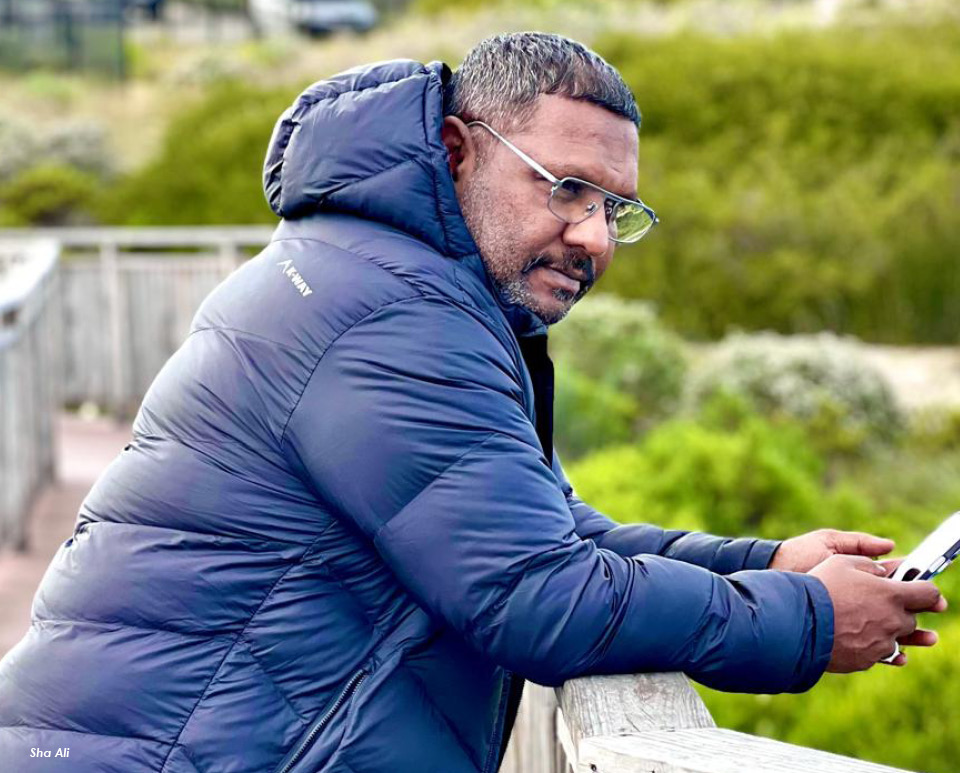
Time: dawn. Location: Cape, South Africa. Challenge: A couple of stubborn camels that refuse to come out of their barn. A long way from home and with the production clock ticking on his biggest-ever Tamil drama, executive producer Sha Ali had little choice but to do his best with the camels at hand. Which is why, when you watch the scene in Mei, you will see four instead of the six camels he had hoped for.
The camels are but one of Ali’s many anecdotes from the multi-country set of, "Mei", Mediacorp’s first crime thriller shot in four countries – Azerbaijan, Malaysia, Singapore and South Africa.
The 26-episode drama for Tamil channel Vasantham is the story of a businessman whose disappearance plunges his family into a dangerous cat and mouse game with an underworld ring, and an Investigation Bureau officer dealing with the disappearance of his partner.
The series, directed by Vel Murugan Deakerajen and S. Kumaran, stars sisters Eswari Gunasagar as Mayuri and Shamini Gunasagar as Mythili, as well as Saravanan Ayyavoo as Arjun.
Just ahead of the series’ premiere on 12 June, Ali talked about a six-year journey to get the series made, including changing the location from Mexico, switching out the loot from gold to diamonds, dropping the drugs, and managing soaring overseas production costs as global streamers drive up pricing.
The result of a win at Mediacorp’s Creative Assembly in December 2021, "Mei" pushes the boundaries of what Ali sees as broadcast TV, in more ways than one.
The story for instance. “Indian TV dramas don’t often reach this level of storytelling,” he says, outlining Mei’s character, plot complexity and seven-minute gunfight climax.
“To capture your audience, you have to go big,” he says. “We have to move to the next level. Regular, local content won’t suffice anymore. You need to push boundaries and explore new horizons."
Having wrestled with Singapore’s too-familiar backdrops of bus stops and void decks, Ali was after a much bigger canvas.
For a Tamil drama,...
Time: dawn. Location: Cape, South Africa. Challenge: A couple of stubborn camels that refuse to come out of their barn. A long way from home and with the production clock ticking on his biggest-ever Tamil drama, executive producer Sha Ali had little choice but to do his best with the camels at hand. Which is why, when you watch the scene in Mei, you will see four instead of the six camels he had hoped for.
The camels are but one of Ali’s many anecdotes from the multi-country set of, "Mei", Mediacorp’s first crime thriller shot in four countries – Azerbaijan, Malaysia, Singapore and South Africa.
The 26-episode drama for Tamil channel Vasantham is the story of a businessman whose disappearance plunges his family into a dangerous cat and mouse game with an underworld ring, and an Investigation Bureau officer dealing with the disappearance of his partner.
The series, directed by Vel Murugan Deakerajen and S. Kumaran, stars sisters Eswari Gunasagar as Mayuri and Shamini Gunasagar as Mythili, as well as Saravanan Ayyavoo as Arjun.
Just ahead of the series’ premiere on 12 June, Ali talked about a six-year journey to get the series made, including changing the location from Mexico, switching out the loot from gold to diamonds, dropping the drugs, and managing soaring overseas production costs as global streamers drive up pricing.
The result of a win at Mediacorp’s Creative Assembly in December 2021, "Mei" pushes the boundaries of what Ali sees as broadcast TV, in more ways than one.
The story for instance. “Indian TV dramas don’t often reach this level of storytelling,” he says, outlining Mei’s character, plot complexity and seven-minute gunfight climax.
“To capture your audience, you have to go big,” he says. “We have to move to the next level. Regular, local content won’t suffice anymore. You need to push boundaries and explore new horizons."
Having wrestled with Singapore’s too-familiar backdrops of bus stops and void decks, Ali was after a much bigger canvas.
For a Tamil drama, the production scale is unprecedented. “We wanted to break that barrier,” Ali says.
A fan of Latin American dramas such as "Queen of the South", Ali envisioned "Mei" as a Tamil series with a global footprint, blending the emotional depth of typical Indian dramas with the expansive, high-stakes narratives often seen in international series... and with a fraction of the budget in places where production costs are at record highs.
Not disclosing numbers, Ali says his “whole drama’s budget is equivalent to what Netflix or Prime Video spends on one episode. So, we had to be very cautious and creative”.
The 90-second sizzle Ali shot during the pandemic for the pitch was set in the U.S., Mexico and Singapore.
Ultimately, the series' storyline dictated its setting, Ali says.
“The countries were chosen by the story, not by us”. For example, with diamonds central to the plot, Africa, with both legal and illegal trade, was a natural choice.
Azerbaijan was picked because of its range of backdrops and its geographic location, which allowed a fictional escape route from Malaysia, to Iran, to Armenia to Russia and Georgia and finally, when there was nowhere else to run, to Azerbaijan.
Apart from the Singapore & Malaysia shoots, Ali shot for 18 days in South Africa, and 25 dedicated shooting days in Azerbaijan of the 40 days the team spent there.
Long distances and shorter daylight hours were challenges.
Some days, “we had to travel two hours each way to the desert locations,” Ali says. “And the sun sets early, so our shooting window was limited.”
And then there were the logistics, including transporting equipment from Singapore to South Africa to – believe it or not – keep costs down.
With rental costs in South Africa at their current highs, it was cheaper to fly everything in, and pay the excess baggage, he says.
In Azerbaijan, Ali was jostling with Indian crews, also after a cost-effective change of scenery.
Ultimately though, "Mei" will rise or fall on the strength of its story.
“We can we can shoot in 10 countries. But if the story is not there, no one will watch. I hope we have done justice to the story. Now it’s up to the audience”.






























